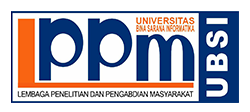PENDEKATAN KOMUNIKASI PARTISIPATORI DALAM PENANGGULANGAN PENYAKIT DI KALANGAN MASYARAKAT MISKIN
Abstract
Indonesia was ranked fourth after India, China, and South Africa in terms of the prevalence of Tuberculosis (TB) with 65,000 deaths per year (WHO 2012). Since 1995 Indonesia implement Directly Observed Treatment Shortcourse (DOTS) as a method of treatment of TB. DOTS method not only be implemented through a clinical approach but also a community-based approach, especially in the poor communities that the prevalence of TB is high. The research used a qualitative approach with case study method of TB control programs in poor urban communities with Community TB Care 'Aisyiyah KPT Jakarta Barat. A total of 18 informants as a source of data, obtained by the snowball technique. The study used a model multitrack participatory communication theory. The results showed that happen combines participatory communication modes monologues and dialogue. Moda monologues occur in training and the delivery of information about the disease and treatment of TB patients, cadres and treatment supervision(PMO) as well as community leaders. While meeting the communication forum Dialogic was formed to solve the problem. Forums and meetings patient monitoring becomes an arena not only the exchange of information on TB treatment but the problem solving and the consultations and the 'vent' in assisting patients. Dialogic participatory modes of communication in health communication is required not only as a transfer of information from the owner of the program but also as an approach to exchange views in order to cure a disease.
Keyword : health communication, participatory communication, tubercolusis
Full Text:
PDFReferences
Airhihenbuwa, CO, Obregon, R. 2000. “A Critical Assesment of Theories/Models Used in Health Communication for HIV/AIDS”. Journal of Health Communication: International Perspectives Volume 05 (supplement) 5-15: http://www.tandfonline.com/doi/abs/10.1080
Brewer, NT , Rimer, BK. 2008. Perspectives on Health Behaviour Theories That Focus On Individuals. Dalam Health Behavior and Health Education Theory, Research, And Practice, 4th Edition. Editors: Karen Glanz, Barbara K. Rimer, K. Viswanath.
Dutta-Bergman. 2009. Theory and Practice in Health Communication Campaigns A Critical Interrogation. Health Communication. Volume 18(02), 103-122: http://www.scirp.org/Journal/PaperInformation
Kementrian Kesehatan Republik Indonesia (Kemenkes). 2007. Pedoman Penanggulangan Tuberkulosis. Jakarta (ID): Kemenkes.
______. 2011. Strategi Nasional Penganggulangan Tuberculosis 2011-2014. Direktorat Jenderal Pengendalian Penyakit dan Penyehatan Lingkungan.
Fitriani E. 2012. “Faktor Risiko Yang Berhubungan Dengan Kejadian Tuberkulosis Paru”. Unnes Journal of Public Health. Volume 1 (2) :http://journal.unnes.ac.id/sju/index.php/ujph
Liliweri A. 2011. Dasar-dasar Komunikasi Kesehatan, Cetakan IV . Yogyakarta (ID): Pustaka Pelajar.
Mefalopulos P, Kamlongera C. 2004. Participatory Communication Strategy Design. FAO of the United Nations, Roma
Miles MB, Huberman AM. 1992. Analisis Data Kua-litatif : Buku Sumber Tentang Metode-Metode Baru. Jakarta (ID): Penerbit Universitas Indonesia Press
Nair KS, White SA. 2004. Participatory Message Development: Conceptual Framework dalam White, SA dan Nair, KS, Ascroft, Joseph. 2004. Participatory Communication Working for Change and development. New Delhi (IN ): Sage Publication India Pvt Ltd.
Rahim SA. 2004. Participatory Development Communication as a Dialogical Process dalam White, SA. 2004. Participatory Communication Working for Change and Development. New Delhi (IN ): Sage Publication India Pvt Ltd.
Ratnasari, Nunik. 2005.Faktor-Faktor Risiko Tb Paru di Beberapa Unit Pelayanan Kesehatan Kota Semarang. Skripsi. Semarang (ID): Universitas Dipenogoro.
Schiavo R. 2007. Health Communication from Theory to Practice. San Fransisco, CA: Jossey Bass
Tufte T, Mefalopulos P. 2009. A practical Guide participatory Communication. Washington (US ) : The World Bank.
WaisbordS. 2007. Beyond the Medical_Informational Model Recasting The Role Of Communication In Tuberculosis Control. Social Science and Medicine Jurnal. Volume 65(06), 2130-2134: http//www.elsevier.com/locate/soscimed.
World Health Organization (WHO). 2012. Global Tuberculosis Report. WHO Regional Office South of Asia, New Delhi (ID). WHO.
DOI: https://doi.org/10.31294/jkom.v7i2.1488
| Index by: | ||








|
||
| E-ISSN: 2579-3292 | ||

 https://road.issn.org/sites/all/themes/customroad/img/road-issn.png
https://road.issn.org/sites/all/themes/customroad/img/road-issn.png
|
||
Dipublikasikan oleh LPPM Universitas Bina Sarana InformatikaJl. Kramat Raya No.98, Kwitang, Kec. Senen, Kota Jakarta Pusat, DKI Jakarta 10450
|








